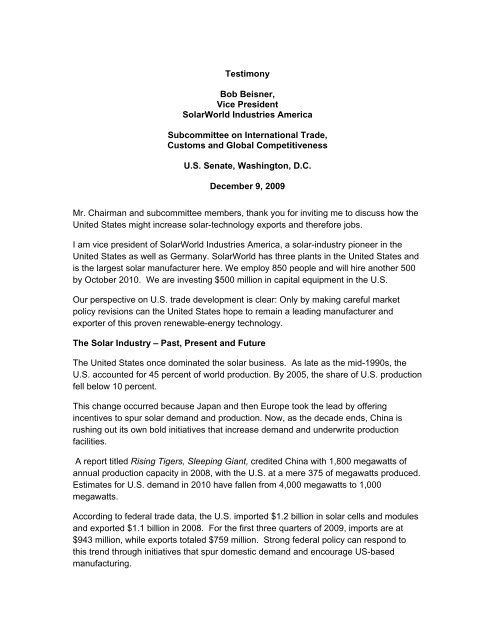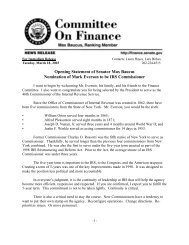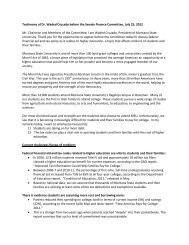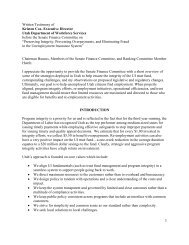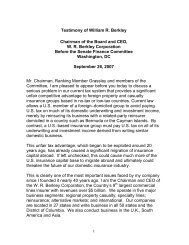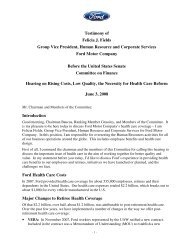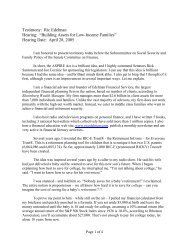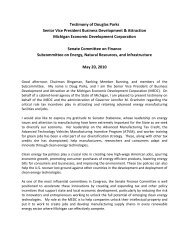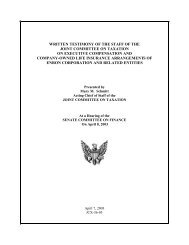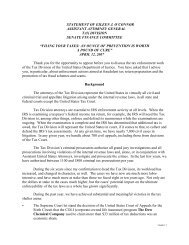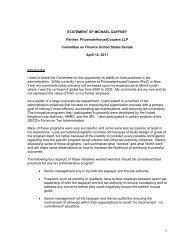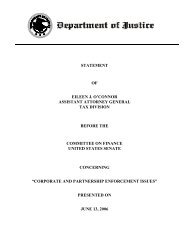Testimony Bob Beisner, Vice President SolarWorld Industries ...
Testimony Bob Beisner, Vice President SolarWorld Industries ...
Testimony Bob Beisner, Vice President SolarWorld Industries ...
Create successful ePaper yourself
Turn your PDF publications into a flip-book with our unique Google optimized e-Paper software.
<strong>Testimony</strong><br />
<strong>Bob</strong> <strong>Beisner</strong>,<br />
<strong>Vice</strong> <strong>President</strong><br />
<strong>SolarWorld</strong> <strong>Industries</strong> America<br />
Subcommittee on International Trade,<br />
Customs and Global Competitiveness<br />
U.S. Senate, Washington, D.C.<br />
December 9, 2009<br />
Mr. Chairman and subcommittee members, thank you for inviting me to discuss how the<br />
United States might increase solar-technology exports and therefore jobs.<br />
I am vice president of <strong>SolarWorld</strong> <strong>Industries</strong> America, a solar-industry pioneer in the<br />
United States as well as Germany. <strong>SolarWorld</strong> has three plants in the United States and<br />
is the largest solar manufacturer here. We employ 850 people and will hire another 500<br />
by October 2010. We are investing $500 million in capital equipment in the U.S.<br />
Our perspective on U.S. trade development is clear: Only by making careful market<br />
policy revisions can the United States hope to remain a leading manufacturer and<br />
exporter of this proven renewable-energy technology.<br />
The Solar Industry – Past, Present and Future<br />
The United States once dominated the solar business. As late as the mid-1990s, the<br />
U.S. accounted for 45 percent of world production. By 2005, the share of U.S. production<br />
fell below 10 percent.<br />
This change occurred because Japan and then Europe took the lead by offering<br />
incentives to spur solar demand and production. Now, as the decade ends, China is<br />
rushing out its own bold initiatives that increase demand and underwrite production<br />
facilities.<br />
A report titled Rising Tigers, Sleeping Giant, credited China with 1,800 megawatts of<br />
annual production capacity in 2008, with the U.S. at a mere 375 of megawatts produced.<br />
Estimates for U.S. demand in 2010 have fallen from 4,000 megawatts to 1,000<br />
megawatts.<br />
According to federal trade data, the U.S. imported $1.2 billion in solar cells and modules<br />
and exported $1.1 billion in 2008. For the first three quarters of 2009, imports are at<br />
$943 million, while exports totaled $759 million. Strong federal policy can respond to<br />
this trend through initiatives that spur domestic demand and encourage US-based<br />
manufacturing.
The International Solar Industry – Government Supported Success Stories<br />
We have witnessed the power of proven policy. Regulations in Germany and Spain<br />
requiring the electric grid to receive power from solar generation sites and incentives to<br />
pay solar-system owners for power fed into the grid helped the solar industry realize<br />
economies of scale.<br />
U.S. feed-in programs have emerged in Florida, Oregon and elsewhere. But the reliable<br />
investment returns they offer remain too scattered to boost demand and the related<br />
domestic production.<br />
Federal leadership has made strides in the provisions of IRS Code that allowed for<br />
parties that are producing power from renewable energy sources to choose either an<br />
investment tax credit or a grant. The American Reinvestment and Recovery Act<br />
provisions for bonds, grants and loans in coordination with the Department of Energy<br />
also provide stimulus for demand and production.<br />
Other pending measures include a solar road map, bonds for Renewable Energy<br />
Development , extension of Investment Tax Credits and conversion of credits to grants<br />
(IRC Section 48), $2.3 billion for support of advanced energy manufacturing (IRC<br />
Section 48C) and the proposed Solar Manufacturing Job Creation Act, S. 2755,<br />
introduced by your colleague Senator Menendez and others.<br />
Additional Steps for US Global Competitiveness<br />
To enable the U.S. to become a major force in solar manufacturing we respectfully<br />
recommend that the subcommittee consider:<br />
� No. 1: Offering states a framework and matching funds to develop feed-in<br />
programs that suit their goals but also work to further broader national objectives<br />
– including progress on the nation’s renewable energy portfolio.<br />
� No. 2: Strengthening manufacturing incentives to hold companies accountable<br />
for creating living-wage jobs in durable, capital-intensive enterprises, not lightfooted<br />
assembly operations.<br />
� No. 3: Expanding domestic source requirements for renewable-energy projects<br />
employing federal stimulus funding to include all projects on federal properties,<br />
regardless of funding.<br />
� No. 4: Seeking greater transparency with our global trading partners on their<br />
business practices to insure fairness with import-export laws and treaties.<br />
Thank you.


